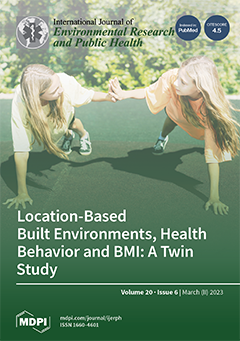Background: Cancer has become a public health problem and a challenge in developing countries, including Ethiopia. There is scanty local data on cancer epidemiology in Amhara region, Ethiopia. Thus, this study aimed to describe epidemiological characteristics of cancer patients attending Felege Hiwot Referral
[...] Read more.
Background: Cancer has become a public health problem and a challenge in developing countries, including Ethiopia. There is scanty local data on cancer epidemiology in Amhara region, Ethiopia. Thus, this study aimed to describe epidemiological characteristics of cancer patients attending Felege Hiwot Referral Hospital. Methods: This study was based on a patient cancer registry that took place in Bahir Dar Felege Hiwot Referral Hospital, Amhara Regional State, Ethiopia. It is the main referral hospital in the Amhara region, and serves more than 5 million people. The hospital has units including oncology for follow-up health care services. All confirmed cancer patients attending oncology units from July 2017 to June 2019 were included in the study. Global Moran’s I statistic was employed to assess spatial heterogeneity of cancer cases across districts. Getis–Ord Gi* statistics was performed to identify hot spot districts with high numbers of cancer cases. Results: In a two-year period, a total of 1888 confirmed cancer patients were registered. There was a significant variation of cancer patients between females (60.8% 95%CI 58.5 to 63.0%) and males (39.3% 95%CI 37.0 to 41.5%). The first three most frequent cancer types seen were breast (19.4%) and cervical cancer (12.9%), and lymphoma (15.7%). Breast and cervical cancer and lymphoma were the first three cancers type among women, whereas lymphoma, sarcoma, and lung cancer were the three most common cancer among men. Spatially, cancer cases were non-random in the study area (global Moran’s I = 0.25, z-score = 5.6,
p-value < 0.001). Bahir Dar city administration (z = 3.93,
p < 0.001), Mecha (z = 3.49,
p < 0.001), Adet (z = 3.25,
p < 0.01), Achefer (z = 3.29,
p < 0.001), Dangila (z = 3.32,
p < 0.001), Fogera (z = 2.19,
p < 0.05), and Dera (z = 2.97,
p < 0.01) were spatially clustered as hotspot with high numbers of cluster cases. Conclusions: We found that there is a variation in the cancer types with sex. This study provides an insight for further exploration of environmental and occupational exposure related factors for cancer to guide future cancer prevention and control programs. The current study also calls for expansion of cancer registry sites, including in rural areas in the region.
Full article





